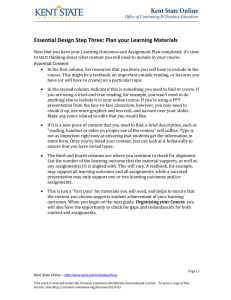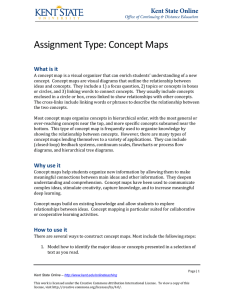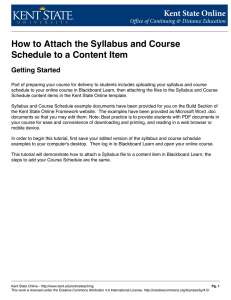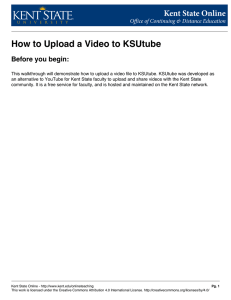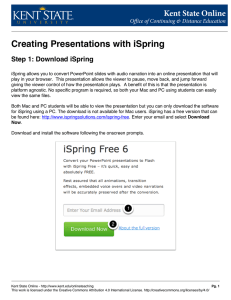Assignment Type: Mind Maps What is it
advertisement
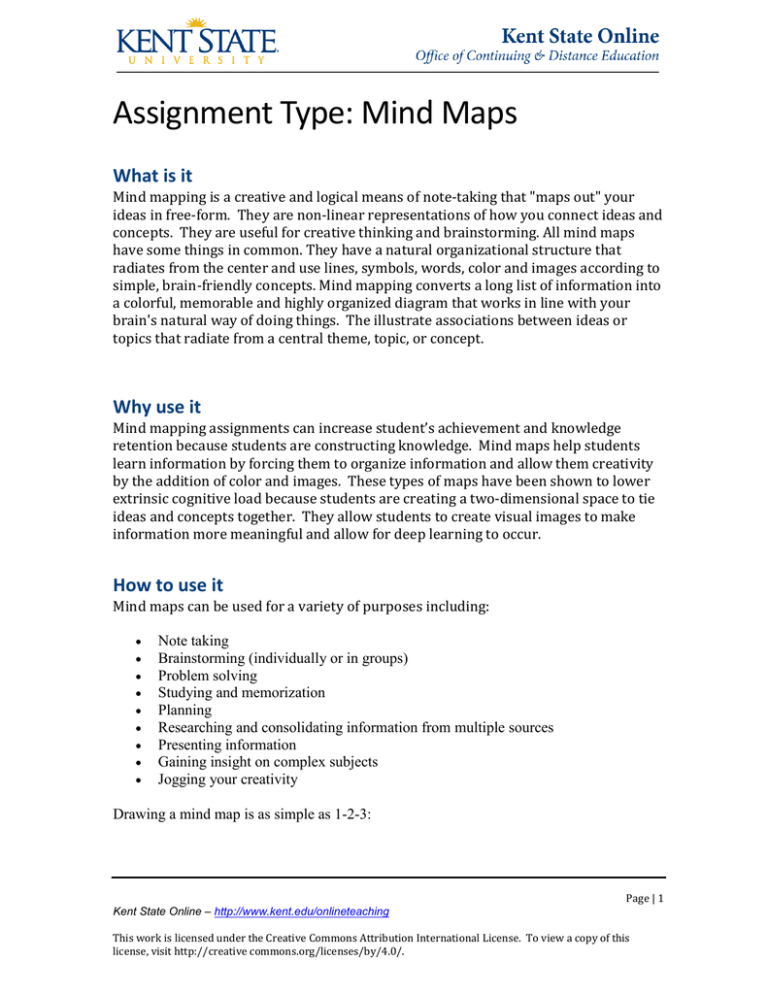
Assignment Type: Mind Maps What is it Mind mapping is a creative and logical means of note-taking that "maps out" your ideas in free-form. They are non-linear representations of how you connect ideas and concepts. They are useful for creative thinking and brainstorming. All mind maps have some things in common. They have a natural organizational structure that radiates from the center and use lines, symbols, words, color and images according to simple, brain-friendly concepts. Mind mapping converts a long list of information into a colorful, memorable and highly organized diagram that works in line with your brain's natural way of doing things. The illustrate associations between ideas or topics that radiate from a central theme, topic, or concept. Why use it Mind mapping assignments can increase student’s achievement and knowledge retention because students are constructing knowledge. Mind maps help students learn information by forcing them to organize information and allow them creativity by the addition of color and images. These types of maps have been shown to lower extrinsic cognitive load because students are creating a two-dimensional space to tie ideas and concepts together. They allow students to create visual images to make information more meaningful and allow for deep learning to occur. How to use it Mind maps can be used for a variety of purposes including: Note taking Brainstorming (individually or in groups) Problem solving Studying and memorization Planning Researching and consolidating information from multiple sources Presenting information Gaining insight on complex subjects Jogging your creativity Drawing a mind map is as simple as 1-2-3: Page | 1 Kent State Online – http://www.kent.edu/onlineteaching This work is licensed under the Creative Commons Attribution International License. To view a copy of this license, visit http://creative commons.org/licenses/by/4.0/. Start in the middle of a blank page, writing or drawing the idea you intend to develop. I would suggest that you use the page in landscape orientation. Develop the related subtopics around this central topic, connecting each of them to the center with a line. Repeat the same process for the subtopics, generating lower-level subtopics as you see fit, connecting each of those to the corresponding subtopic. Some more recommendations: Use colors, drawings and symbols copiously. Be as visual as you can, and your brain will thank you. I’ve met many people who don’t even try, with the excuse they’re "not artists". Don’t let that keep you from trying it out! Keep the topics labels as short as possible, keeping them to a single word – or, better yet, to only a picture. Especially in your first mind maps, the temptation to write a complete phrase is enormous, but always look for opportunities to shorten it to a single word or figure – your mind map will be much more effective that way. Vary text size, color and alignment. Vary the thickness and length of the lines. Provide as many visual cues as you can to emphasize important points. Every little bit helps engaging your brain. Considerations Acknowledge that some students may feel uncomfortable with this type of assignment. Some may fear that their thought process are inadequate or that they have to be an artist to add creativity to their mind map. In addition, mind maps may not be an effective learning tool for all students since some may like to create linear lists. Prepare students well for what is expected of them. You may want to consider creating a narrated presentation on mind mapping and walk them through your expectations and the steps involved in creating a mind map. Also consider posting examples of mind maps to further assist students. Instruction and Assessment Providing clear instructions on how to create a mind map is essential. There are many concept mapping programs available. Many programs offer a 30-day free trial, but others are free to download and utilize. In addition, many have tutorials built into the website to help you get started. A few free programs available for creating mind maps are Edraw Mind Map Blumind The software listed have many embedded features to help you with constructing your mind map and both available for MAC and PC users. Page | 2 Kent State Online – http://www.kent.edu/onlineteaching This work is licensed under the Creative Commons Attribution International License. To view a copy of this license, visit http://creative commons.org/licenses/by/4.0/. Students may be apprehensive about using a software package to create their mind map. They can also create them by-hand and scan the image to submit for feedback and/or grading. Some students may feel it is easier to construct them by hand because this allows for a free flow of ideas. Please encourage students to start their mind maps early, since they may have questions as they start brainstorming. You may want to consider having students create mind maps on a topic and post to a discussion forum to generate dialogue on the similarities and differences between the maps. Level of Bloom’s Taxonomy: Sample Action Verbs Assignments using mind maps are probably best constructed to work toward accomplishment of learning outcomes at lower cognitive levels. Here are a few examples of action verbs from the relevant levels of Bloom’s cognitive domains: Remembering: Identify, List, Record, Show Understanding: Associate, Characterize, Review Applying: Construct, Illustrate, Investigate, Relate Resources Difference Between Concept and Mind Mapping o This articles explains and provides relevant examples of the differences between concept maps, mind maps, and argument maps. A table is provided to highlight the differences in purpose, structure, level of abstraction, nodes, linking devices, linking words, and language that is utilized to create the three types of mapping activities. o Reference: Davies, M. (2011). Concept mapping, mind mapping and argument mapping: what are the differences and do they matter? Higher Education, 62(3), 279-301. doi:10.1007/s10734-010-9387-6 Mind Mapping Website o The website provides information regarding the theory behind mind maps, uses of mind maps, and software tips and reviews. The website contains numerous links to relevant mind mapping websites to further help you provide examples and instructions on how to create one. Page | 3 Kent State Online – http://www.kent.edu/onlineteaching This work is licensed under the Creative Commons Attribution International License. To view a copy of this license, visit http://creative commons.org/licenses/by/4.0/. The Mind Map Book: How to Use Radiant Thinking to Maximize Your Brain's Untapped Potential o A comprehensive text on mind mapping divided into five sections natural architecture, foundations, structure, synthesis, and uses. The text is rich with information, examples, and exercises to help you understand mind maps. It offers exciting new ways of using and improving memory, concentration, and creativity in planning and structuring thought on all levels, in order to accelerate the ability to learn, remember, and record information. o Reference: Buzan, T. & Buzan, B. (1996). The mind map book: How to use radiant thinking to maximize your brain's untapped potential. New York, NY: Plume. Educational Technology and Mobile Learning Website o The website provides a variety of mind mapping tools for teachers and students. Using Mind Maps as a Teaching and Learning Tool to Promote Student Engagement o This article discusses what mind maps are, provides links to software, and explains two different assignments that use mind maps. o Reference: Zipp, G.P. (2011, September 7). Using mind maps as a teaching and learning tool to promote student engagement. Faculty Focus. Retrieved from http://www.facultyfocus.com/articles/teachingand-learning/using-mind-maps-as-a-teaching-and-learning-tool-topromote-student-engagement/ Page | 4 Kent State Online – http://www.kent.edu/onlineteaching This work is licensed under the Creative Commons Attribution International License. To view a copy of this license, visit http://creative commons.org/licenses/by/4.0/.
